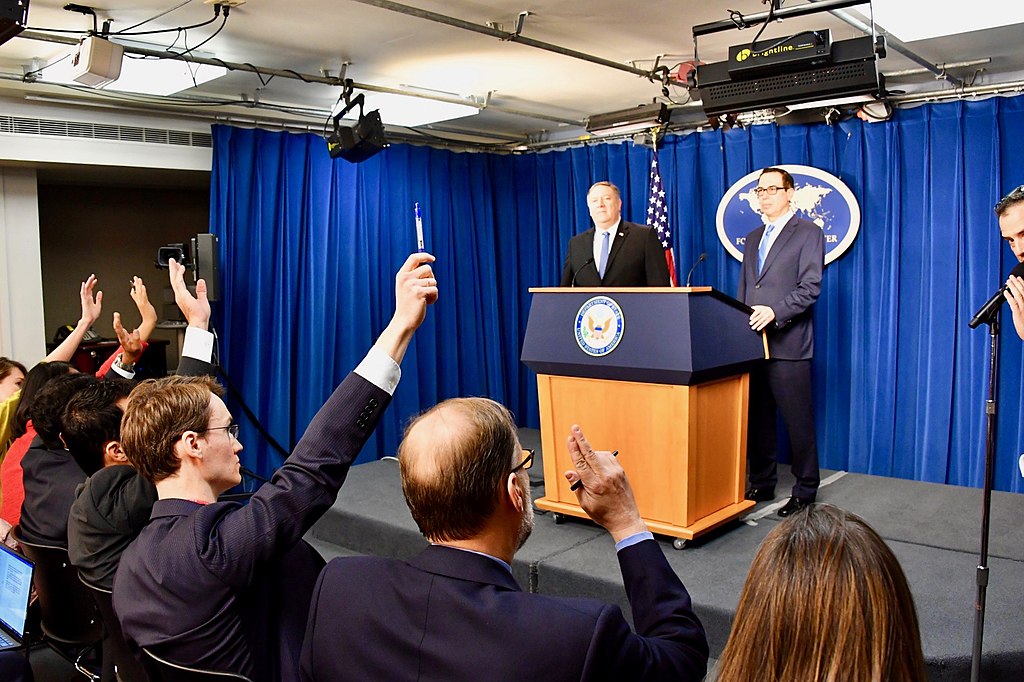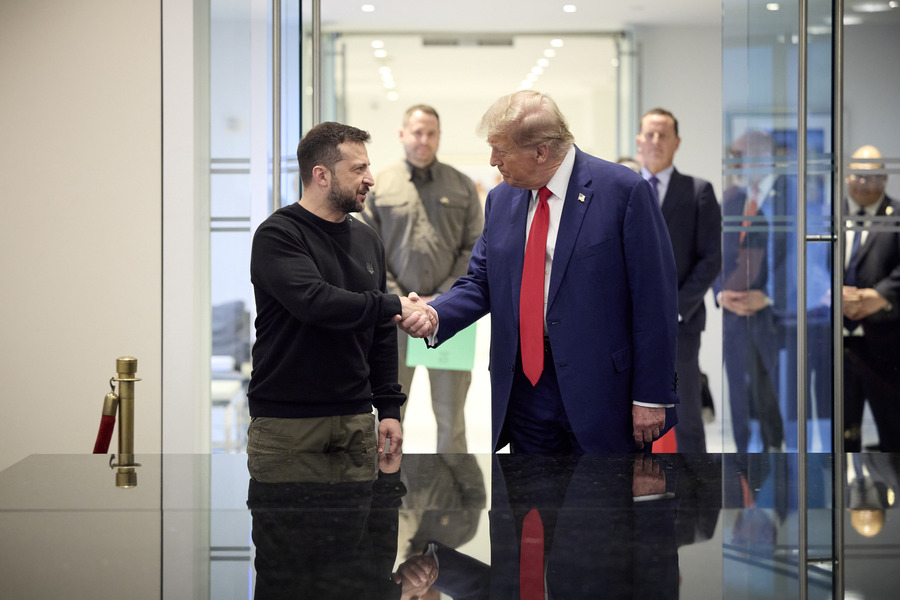Introducing a New Paper on ‘Weaponized Interdependence’
Last month, Ellie Geranmayeh and Manuel Lafont Rapnouil wrote a report for the European Council on Foreign Relations, arguing that Europe needed to hit back hard against U.S. secondary sanctions targeting Iran. They recommended that Europe consider measures such as creating new financial channels outside U.S. control, investigating European companies that comply too readily with U.S. threats and targeting U.S. companies in retaliation for sweeping U.S.

Published by The Lawfare Institute
in Cooperation With

Last month, Ellie Geranmayeh and Manuel Lafont Rapnouil wrote a report for the European Council on Foreign Relations, arguing that Europe needed to hit back hard against U.S. secondary sanctions targeting Iran. They recommended that Europe consider measures such as creating new financial channels outside U.S. control, investigating European companies that comply too readily with U.S. threats and targeting U.S. companies in retaliation for sweeping U.S. measures against European firms.
As the international nuclear deal with Iran known as the Joint Comprehensive Plan of Action (JCPOA) unravels, Europeans feel the bite of U.S. secondary sanctions and economic coercion, and many have come to believe that Europe needs to build up its own coercive tools to pursue its strategic goals and deter U.S. overreach. China and Russia too are starting to think more systematically about how they can use economic coercion and prevent others from coercing them. As allies, rivals and adversaries strengthen and employ their capacity for economic coercion, the U.S. is likely to retaliate in turn, generating new power dynamics.
National security and economic policy used to be separate spheres. They are now merging, turning the global networked economy into a space of strategic actions, counteractions, threats, targeting, countertargeting and decoupling.
We start to describe and explain this emerging world in our new article, “Weaponized Interdependence: How Global Economic Networks Shape State Coercion,” which has just come out in International Security. Mapping the strategic landscape of the new world and preventing destabilizing mistakes requires the academic and policy community to think about secondary sanctions and other forms of economic coercion as part of an emerging system, rather than discrete actions. “Weaponized Interdependence” explains how the broad structural features of the global economy enable some states while constraining others, providing a theory of power in the new world order.
As we show, the politics of sanctions and other forms of economic coercion have been transformed by globalization. It used to be that sanctions rested on a country’s ability to prevent outsiders from access to its internal market. Now, however, proper participation in the world economy requires access to global networks such as the dollar clearing system and the SWIFT financial network. We live in an interdependent world, but one where the dependencies are asymmetric. Some countries—most prominently the U.S.—are able to cut businesses or even entire countries out of these global networks, with profound economic consequences.
Crucial global economic networks are not the kind of open-ended networks, capable of overturning power asymmetries and toppling political hierarchy, of which globalizers dreamed of. Instead, they tend to be highly centralized. Networks comprise two basic elements: the nodes, which represent the actors or locations within the network, and the ties, which connect these nodes together. Many world-spanning economic networks evolve so that some nodes become far more important than others, channeling and even directing the flows in the rest of the network; for example, the dollar clearing system, which is crucial to international financial flows, runs through a very small number of key U.S. institutions. Such nodes, in turn, can become vectors for state control. If a state has jurisdiction over the key nodes in an important global network along with appropriate institutions, it can weaponize the network, using it to conduct surveillance or to block others from accessing the network in question.
The weaponization of global networks is the driving force of the new geopolitics, supplementing traditional forms of coercion based on conditioning access to a country’s internal market. Global dependence on organizations like SWIFT, which serves as a secure messaging service for global finance, or Google and its Android operating system, become a new source of leverage over adversaries. Countries that have jurisdiction and control over key hubs in global networks have vast extraterritorial influence. Network structures are creating new power asymmetries by distributing strategic clout to some states but not others.
Equally, though, these structures may not endure forever. If states overuse their control of central nodes, they run the risk that other states and businesses will start to push back—or even create their own alternative networks. Europe, in the case of Iran, has created a special purpose vehicle, known as INSTEX, to route around the U.S. payment system.
Geranmayeh and Rapnouil’s proposals are driven by their understanding of how these network dynamics disadvantage Europe. They explain how the U.S. has weaponized interdependence against European states and firms—but argue that Europe does not have to remain supine. If Europe builds up the appropriate capacities, in their view, it can potentially deter the U.S. from overreach in the future.
Their argument implies that one reason the U.S. has overused its extraterritorial power is because it does not have to worry about pushback. If Europe builds up its own coercive clout, by contrast, the U.S. will have to think twice before it acts unilaterally in the future. The trans-Atlantic relationship used to involve cooperation over economic coercion (the U.S. and Europe agreed on sanctions and measures involving SWIFT to press Iran into the negotiations that led to the JCPOA). Under the Trump administration, however, that relationship has turned into one of unilateral coercion on the part of the United States, as the U.S. attempts to isolate Iran and perhaps even change the Iranian regime in the face of European attempts to keep the agreement alive. Now Geranmayeh and Rapnouil suggest that Europe follow the logic of mutual deterrence, at least for the moment.
Similar tensions exist in the relationship between the U.S. and China. Chinese officials increasingly view U.S. efforts to undermine Huawei as motivated by the U.S. desire to undermine China as a strategic competitor. The U.S. intelligence community, by contrast, views Huawei as a Trojan horse aimed at reshaping global communications networks so that, instead of favoring U.S. surveillance, they might favor China. Both view control over key telecommunications infrastructure as not simply an economic game but a security issue as well.
These tensions are spurring hostility and “decoupling” as the U.S. takes measures against Chinese firms such as Huawei and rethinks its supply chains, while China retaliates against countries like Canada (for holding a senior Huawei executive on bail at the request of the U.S.) and moves toward technology independence. Heated actions and rhetoric lead many observers to fear that the world is entering into a new Cold War. However, the new international logic that is unfolding is much stranger than the Cold War, which saw only limited economic contact between the Soviet bloc and the West. This new world coming into being combines increased political rivalry with deep economic entanglements.
There is another important difference. The Cold War, once it had become properly established, was a system of commonly shared understandings, aimed at minimizing the risk of near catastrophes such as the Cuban missile crisis. Deterrence didn’t start to work properly until everyone understood everyone else’s capabilities, goals and core sensitivities well enough to avoid basic mistakes, miscalculation, and destabilizing patterns of retaliation and counterretaliation.
The stakes are lower in the new era of strategic economic competition: After all, there is no direct risk comparable to nuclear Armageddon. But the rules are also much hazier. Even the most sophisticated actors, such as the U.S. Department of Treasury’s Office of Foreign Assets Control, do not always have a good understanding of the networks of economic and financial relations they are weaponizing and, as a result, also lack an understanding of the risks of inadvertent side effects.
As other, less experienced states develop their own coercive strategies, the risks of mistakes and of escalating series of actions and counteractions will rise dramatically. There is no proper strategic understanding of the new geopolitics. The key actors concerned have yet to start thinking systematically about how others are going to respond to their own actions, working out the plausible chains of consequences.
Building such a strategic understanding not only will require scholarship like ours but also will have to draw on research in law, financial history, business administration, economics and other fields. It will also require extensive empirical research, to map out the networks and dependencies that form the contours of the new strategic landscape. This intellectual groundwork is urgently necessary.
On the one hand, the U.S. cannot just keep on using economic coercion on the assumption that others will not respond. Some U.S. policymakers already recognize this (then-Treasury Secretary Jacob Lew warned of the risks shortly before he left office), but the U.S. debate is hampered by the lack of clear understanding of the precise sources of U.S. coercive power and how other states might look to circumvent or even undermine it. U.S. policymakers should pay close attention to Geranmayeh and Rapnouil’s paper, which reflects internal debates in Europe (Rapnouil has just become the head of policy planning for France’s foreign ministry), and to similar debates taking place in China and Russia.
On the other hand, Europeans also need to think strategically. Can an institution such as the European Union develop coercive structures, given its internal divisions? How would the U.S. respond to increased European pushback—with conciliation, or with more aggressive and punitive policies? Will Brexit (and the loss of the City of London, which is Europe’s closest equivalent to a cluster of key nodes in global financial networks) undermine Europe’s coercive power? Might future cooperation with the U.S. have its attractions under a less intransigent future administration, and, if so, which institutions might contribute to cooperation and which forestall it? European policymakers—like their U.S. equivalents, not to mention their Chinese and Russian counterparts—need new analytic tools to determine whether their actions might have unexpected consequences.
Scholars of coercion are at the very early stages of understanding the strategic aspects of the new geopolitics. Still, by looking to traditional understandings of international strategic politics, we as a community of scholars and practitioners can draw some very broad conclusions. As it did during the Cold War, mutual deterrence may offer some stability—but only if the adversarial parties develop common understandings.
First, capabilities are key to power. Those actors that do not have sufficient capacity to engage in geopolitics will be disadvantaged—whether because they lack jurisdiction over core nodes in global networks or have underdeveloped internal markets or weak institutions that do not allow them to control networks. This poses different challenges to Europe (where common EU-level institutions are underdeveloped) and China (which has little control over key nodes in global networks and has to leverage access to its internal market as an imperfect substitute).
Second, states’ ability to exercise this power will depend on their credibility. Thomas Schelling’s lessons about the crucial role of credibility and reputation seem to largely be lost on the Trump administration. A chaotic policymaking process, in which strategic calculus seems to play second fiddle to short-term deal making (as witnessed by the administration concessions on ZTE and likely concessions on Huawei), damages the credibility of U.S. institutions in the eyes of allies, adversaries and global businesses.
Third, much of the action will involve the networks themselves. Unlike during the Cold War, which largely involved maneuvering among states, private businesses play a key role in weaponized interdependence. Whether states can use economic networks for coercive ends will depend then on whether firms are willing to comply. Multinationals’ corporate counsel, company compliance departments, business strategists and brand managers will play a key role in shaping business responses to state demands.
Finally, chains of action and counteraction may lead to rapid escalation. This poses obvious risks, especially if economic measures increase the chance of military confrontation, as with Iran in the wake of the breakdown of the JCPOA. Even when they do not lead to military tensions, economic coercion and countercoercion can have substantial fallout, especially for businesses caught in the crossfire. States should think carefully about the risks of escalation when they undertake actions, and they should be especially careful to think through whether or not they have escalation dominance (that is, whether they or the states they are targeting will suffer more from an escalation spiral). States will probably make many mistakes over the next few years, given the lack of commonly available knowledge about each others’ vulnerabilities, goals and endurance. In the long run, policymakers need new rules of the road to minimize miscalculations and risky escalation in the age of weaponized interdependence.





